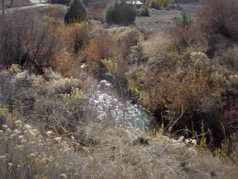By Felice Pace
North Group
The rains have finally come in sufficient quantity to open dewatered creeks. And while these stream openings came too late to aid Chinook salmon, they have allowed Coho to access key spawning grounds in the upper Scott River basin where years of effort and millions of dollars in taxpayer funds have been invested protecting and extending Coho spawning habitat.
Coho being able to make it to habitat that has been protected and enhanced for their use is good news. But bad news also came this fall in reports from the California Department of Fish & Wildlife on how many adult Chinook and Coho salmon passed counting weirs located low on the Scott and Shasta rivers.
The counting weirs were removed on December 31st; by then most spawners should have passed by counting locations en route to spawning grounds upstream. Preliminary counts are:
- Scott River: 1505 Chinook and 334 Coho
 Shasta River: 5867 Chinook and 61 Coho
Shasta River: 5867 Chinook and 61 Coho
These counts do not bode well for Coho salmon in these major Klamath River tributary basins. Salmon biologists tell us that a minimum of 500 spawners is needed to maintain the genetic strength of a population segment or, as we say in the fisheries world, a salmon stock. When there are fewer than 500 spawners, the genetic diversity of the stock narrows and that in turn makes the stock more susceptible to extinction/extirpation via random events.
The Scott River was once the preeminent Coho Salmon stronghold within the Klamath River Basin and it could be that stronghold now. Yet inadequate stream flows and disease epidemics related to flow and poor water quality limit juvenile survival not only in the Shasta and Scott tributaries but in the Klamath River as well. As reflected in DFW’s spawner counts, Coho salmon remain in deep trouble in the Scott and Shasta Rivers and basin-wide. They could be wiped out if we once again have a series of years in which most juvenile salmon die before they can reach the Pacific.
In the Scott River Basin, thousands of Chinook and Coho juveniles die every year when irrigators turn on stream diversions during springtime in a manner that dewaters the streams below the diversions. Dewatering fish habitat by diversion is illegal under California law. That law, however, Fish & Game Code 5937, is intentionally not enforced.
To make matters worse, the Siskiyou County Superior Court recently irresponsibly granted a petition from Scott River Irrigators to end watermaster service (https://water.ca.gov/Programs/All-Programs/System-Reoperation-Program/Watermaster-Services). As a result, irrigation districts like the Farmer's Ditch, which has a documented history of excessive diversion outside the legal irrigation season, are free to violate the conditions of their water right at will. The result is even longer periods when more of Scott River is dewatered. This will inevitably push Scott River Coho closer to extirpation/extinction:
So far the tribes and fishing groups that have sued the US Bureau of Reclamation to get more flows into the Klamath River have not taken legal action to address the dewatering of Scott River and the resulting destruction of the Scott's salmon stocks even as matters have become more dire with the end of watermaster service. The lack of effective action on behalf of Scott River Coho and Chinook salmon is, in my view, disgraceful and shortsighted. Too many of those who are paid to protect Klamath River Basin salmon are preoccupied with dam removal; too little attention is being given to Shasta and Scott River salmon.
If you are reading this report, you can do something to help this situation. It is the responsibility of the State Water Resources Control Board to end the illegal use of water in the Scott River Basin. Nevertheless, in spite of years of Public Trust Complaints, the State Board has not taken meaningful action to end illegal and excessive use of water for irrigation. Please contact the State Board and urge them to take effective action. Below is contact information for the key staff member:
Erik Ekdahl, Deputy Director,
Division of Water Rights
State Water Resources Control Board
Sacramento, CA 95814
(916) 341-5316
Erik.Ekdahl@waterboards.ca.gov
…………………..
Please join us!
The North Group's Executive Committee meets on the second Tuesday of each month in the first floor conference room at the Adorni Center on the waterfront in Eureka. The meeting, which covers regular business and conservation issues, begins at 6:45 PM. Members and non-members with environmental concerns are encouraged to attend. When a new person comes to us with an environmental issue or concern, we often place them first or early on the agenda.